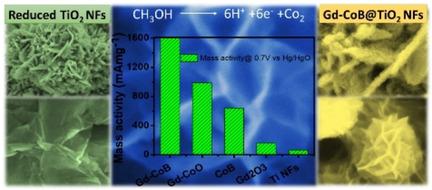当前位置:
X-MOL 学术
›
ChemCatChem
›
论文详情
Our official English website, www.x-mol.net, welcomes your
feedback! (Note: you will need to create a separate account there.)
Surface Assembling of Highly Interconnected and Vertically Aligned Porous Nanosheets of Gd−CoB on TiO2 Nanoflowers for Durable Methanol oxidation Reaction
ChemCatChem ( IF 3.8 ) Pub Date : 2020-03-23 , DOI: 10.1002/cctc.202000392 Tanveer ul Haq 1 , Yusuf Bicer 1 , Akhtar Munir 2 , Said A. Mansour 3 , Yousef Haik 1
ChemCatChem ( IF 3.8 ) Pub Date : 2020-03-23 , DOI: 10.1002/cctc.202000392 Tanveer ul Haq 1 , Yusuf Bicer 1 , Akhtar Munir 2 , Said A. Mansour 3 , Yousef Haik 1
Affiliation

|
Being a green and carbon‐neutral technology, direct methanol fuel cell (DMFC) has attracted much attention while endowing highest mass energy density at low operating temperature. However, the multistep and multielectron process of methanol oxidation reaction (MOR) taking place at the anodic side in DMFC is an energy intense process. In addition, the in situ generated CO can severely deteriorate the catalytic efficiency of electrode material, which can be, however, realized to develop a competent catalytic module. Here, we present a first report on a highly interconnected and facile growth of vertically aligned Gd doped CoB assembled on the surface of rationally developed TiO2 nanoflower (NFs) for MOR. Initially, we developed the TiO2 NFs as support followed by cathodic deposition of Gd−CoO to create an electronic contact with underlying support. After then, finally treated with NaBH4 to further modify the surface of overall hybrid material, characterized with various techniques (UPS, XPS, XRD, SEM, TEM, Raman, and BET analyzer). During electrocatalysis, Gd−CoB@TiO2 was found highly efficient with inherently low charge transfer resistance (Rct) and ability to generate highest current density (400 mA/cm2) with negligible loss in activity even after long term stability (20 h) while using highly concentrated methanol. Meanwhile, the surface modification with B, extended and highly interconnected nature of amorphous and promisingly mesoporous nanosheets in 3D manner further ameliorate the available surface for catalysis. In comparison with analogues samples and literature, it is anticipated that Gd could modify the electronic structure of overall hybrid in such way to energize the redox couple of Co+2/+3 in Gd−CoB against the CO poisoning effect. Further, the XPS and Raman analysis before and after catalysis also indicates that in‐situ generated oxide/hydroxide formation with high inherent polarizability weaken the C−O−H bond of methanol and thus facilitate the dynamic release of involved intermediates.
中文翻译:

TiO2纳米花上Gd-CoB的高度互连和垂直排列的多孔纳米片的表面组装,用于持久的甲醇氧化反应
作为一种绿色环保且碳中和的技术,直接甲醇燃料电池(DMFC)在低工作温度下获得最高质量能量密度的同时备受关注。但是,在DMFC的阳极侧发生的甲醇氧化反应(MOR)的多步多电子过程是能量密集的过程。另外,原位产生的CO会严重降低电极材料的催化效率,然而,可以实现开发有效的催化模块。在这里,我们提出了关于在MOR上合理开发的TiO 2纳米花(NFs)表面组装的垂直排列的掺Gd的CoB高度互连且容易生长的第一份报告。最初,我们开发了TiO 2NFs作为支撑物,然后阴极沉积Gd-CoO,以形成与基础支撑物的电子接触。此后,最后用NaBH 4处理以进一步修饰整体杂化材料的表面,并使用各种技术(UPS,XPS,XRD,SEM,TEM,Raman和BET分析仪)进行表征。在电催化过程中,发现Gd-CoB @ TiO 2具有很高的效率,其固有的低电荷转移电阻(R ct)和产生最高电流密度(400 mA / cm 2)的能力),即使在使用高浓度甲醇的长期稳定性(20小时)后,其活性损失也可以忽略不计。同时,以3D方式使用B进行的表面改性,无定形和有希望的介孔纳米片的扩展和高度互连的性质进一步改善了可用于催化的表面。与类似物样品和文献相比,可以预料到,Gd可以改变整体杂化体的电子结构,从而为Gd-CoB中的Co + 2 / + 3氧化还原对提供能量,以抵抗CO中毒作用。此外,XPS和前和后催化拉曼分析还表明,在原位 生成的具有固有极化率高的氧化物/氢氧化物的形成会削弱甲醇的C-OH键,因此有助于动态释放所涉及的中间体。
更新日期:2020-03-23
中文翻译:

TiO2纳米花上Gd-CoB的高度互连和垂直排列的多孔纳米片的表面组装,用于持久的甲醇氧化反应
作为一种绿色环保且碳中和的技术,直接甲醇燃料电池(DMFC)在低工作温度下获得最高质量能量密度的同时备受关注。但是,在DMFC的阳极侧发生的甲醇氧化反应(MOR)的多步多电子过程是能量密集的过程。另外,原位产生的CO会严重降低电极材料的催化效率,然而,可以实现开发有效的催化模块。在这里,我们提出了关于在MOR上合理开发的TiO 2纳米花(NFs)表面组装的垂直排列的掺Gd的CoB高度互连且容易生长的第一份报告。最初,我们开发了TiO 2NFs作为支撑物,然后阴极沉积Gd-CoO,以形成与基础支撑物的电子接触。此后,最后用NaBH 4处理以进一步修饰整体杂化材料的表面,并使用各种技术(UPS,XPS,XRD,SEM,TEM,Raman和BET分析仪)进行表征。在电催化过程中,发现Gd-CoB @ TiO 2具有很高的效率,其固有的低电荷转移电阻(R ct)和产生最高电流密度(400 mA / cm 2)的能力),即使在使用高浓度甲醇的长期稳定性(20小时)后,其活性损失也可以忽略不计。同时,以3D方式使用B进行的表面改性,无定形和有希望的介孔纳米片的扩展和高度互连的性质进一步改善了可用于催化的表面。与类似物样品和文献相比,可以预料到,Gd可以改变整体杂化体的电子结构,从而为Gd-CoB中的Co + 2 / + 3氧化还原对提供能量,以抵抗CO中毒作用。此外,XPS和前和后催化拉曼分析还表明,在原位 生成的具有固有极化率高的氧化物/氢氧化物的形成会削弱甲醇的C-OH键,因此有助于动态释放所涉及的中间体。









































 京公网安备 11010802027423号
京公网安备 11010802027423号